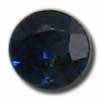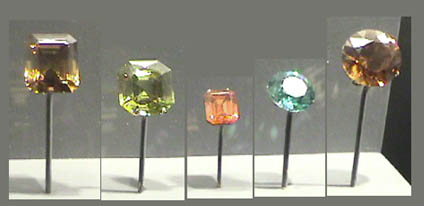








JACINTH (HYACINTH)
Rev 21:20
Jacinth is a derivation of the word “hyacinth” which comes from the Greek huakinthos. Most scholars agree that it was some kind of blue stone, taking it’s color from the flower. It is the 11th foundation stone in the New Jerusalem. Pliny (AD 23-69) describes the hyacinthus as being very different from amethystus, "though partaking of a color that closely' borders upon it" and as being of a more diluted violet, It is held that the jacinth/hyacinth may actually be the sapphire of today.

Stone's names: The orange variety of zircon is called jacinth.
Jacinth is a red transparent variety of zircon used as a gemstone. Jacinth is also a flower of a reddish blue or deep purple (hyacinth), and hence a precious stone of that colour (Revelation 21:20). It has been supposed to designate the same stone as the ligure (Hebrew leshem) mentioned in Exodus 28:19 as the first stone of the third row in the high priest's breast-plate, the Hoshen. In Revelation 9:17 the word is simply descriptive of colour.
"Jacinths" are mentioned as decorating the city of Iram in Richard Francis Burton's translation of the Arabian Nights.
Alfred, Lord Tennyson used the word 'jacinth' in his epic Morte D'Arthur, describing the jewelled hilt of Excalibur:
-
- "There drew he forth the brand Excalibur,
- And o'er him, drawing it, the winter moon,
- Brightening the skirts of a long cloud, ran forth
- And sparkled keen with frost against the hilt:
- For all the haft twinkled with diamond sparks,
- Myriads of topaz-lights, and jacinth work
- Of subtlest jewellery."
- "There drew he forth the brand Excalibur,
J.R.R. Tolkien used the word 'jacinth' to describe the deep-blue wall of space in his poem, The Happy Mariners:
- "Past sunless lands to fairy leas
- Where stars upon the jacinth wall of space
- Do tangle burst and interlace"
Jacinth
by Wayne Blank
Jacinth
 As with so many things introduced in earlier Bible History, the precious stones in the breastpiece of the High Priest (see Levites and Aaron) were symbolic of what was, and is, to come.
As with so many things introduced in earlier Bible History, the precious stones in the breastpiece of the High Priest (see Levites and Aaron) were symbolic of what was, and is, to come.
"And you shall make a breastpiece of judgment, in skilled work; like the work of the ephod you shall make it; of gold, blue and purple and scarlet stuff, and fine twined linen shall you make it. It shall be square and double, a span its length and a span its breadth. And you shall set in it four rows of stones. A row of sardius, topaz, and carbuncle shall be the first row; and the second row an emerald, a sapphire, and a diamond; and the third row a jacinth, an agate, and an amethyst; and the fourth row a beryl, an onyx, and a jasper; they shall be set in gold filigree. There shall be twelve stones with their names according to the names of the sons of Israel; they shall be like signets, each engraved with its name, for the twelve tribes." (Exodus 28:15-21 RSV)
Jacinth will be one of the precious stones in the foundations of the New Jerusalem, on earth (note also in Revelation 21:21, included below, that the famous "Pearly Gates" will also be on earth):
"And in the Spirit he carried me away to a great, high mountain, and showed me the holy city Jerusalem coming down out of heaven from God, having the glory of God, its radiance like a most rare jewel, like a jasper, clear as crystal. It had a great, high wall, with twelve gates, and at the gates twelve angels, and on the gates the names of the twelve tribes of the sons of Israel were inscribed; on the east three gates, on the north three gates, on the south three gates, and on the west three gates. And the wall of the city had twelve foundations, and on them the twelve names of the twelve apostles of the Lamb.""And he who talked to me had a measuring rod of gold to measure the city and its gates and walls. The city lies foursquare, its length the same as its breadth; and he measured the city with his rod, twelve thousand stadia; its length and breadth and height are equal. He also measured its wall, a hundred and forty-four cubits by a man's measure, that is, an angel's. The wall was built of jasper, while the city was pure gold, clear as glass. The foundations of the wall of the city were adorned with every jewel; the first was jasper, the second sapphire, the third agate, the fourth emerald, the fifth onyx, the sixth carnelian, the seventh chrysolite, the eighth beryl, the ninth topaz, the tenth chrysoprase, the eleventh jacinth, the twelfth amethyst. And the twelve gates were twelve pearls, each of the gates made of a single pearl, and the street of the city was pure gold, transparent as glass." (Revelation 21:10-21 RSV)
Stone's names: The orange variety of zircon is called jacinth.
Zircon provides the wearer with wisdom, honor and riches.
Color: Zircon is known as a colorless stone used to imitate diamonds, but also comes in: blue, yellow, orange, red, brown and green.
Description: ZrSiO4 Zircon is a silicate mineral, zirconium silicate.
The high refractive index and dispersion of zircon cause it to approach diamond in fire and brilliancy. Zircon is widespread as an accessory mineral in acid igneous rocks, it also occurs in metamorphic rocks and, fairly often, in detrital deposits.
The name's origin: The name Zircon is originated from Persian Zargun which means "gold color".
Birthstone: Zircon along with turquoise are birthstones of Sagittarius (Archer): Nov. 22-Dec. 21.
Varieties: Zircon is quite widely used in its three varieties. The first variety is called jacinth (also spelled hyacinth) and was used to a great extent in classical antiquity. It occurs in the clear, transparent red, orange, and yellow colors.
The blue variety is called starlite or Siam Zircon, while the third colorless variety is called Ceylon or Matura diamond.
Care and treatment: Zircon will chip and crack rather easily though it has a hardness rating of 7. As with all gems, protect zircon from scratches and sharp blows. Avoid hot water, sudden temperature changes and household chemicals. Store a jewelry made of zircon in separate boxes.
From the stone history: Zircon has been around in jewelry for hundreds of years. It is known for its high dispersion and for many years was used to imitate diamonds.
Shopping guide: Be ware of colorless glass and synthetic spinel zircon imitations.
Healing ability: Zircon relieves pain. It is said to whet one's appetite. Zircon also prevents nightmares and ensures a deep tranquil sleep.
Mystical power: Zircon supposedly helps one be more at peace with oneself. Zircon is believed to provide the wearer with wisdom, honor and riches. The lost of luster on a Zircon stone is said to warn of danger.
Jacinth helps rising one's self-esteem.
Deposits: It occurs in beach sands in many parts of the world, particularly Australia, India, Brazil, and Florida. Gem varieties occur in stream gravels and detrital deposits, particularly in Indochina and Sri Lanka, but also in Burma, Australia, and New Zealand. Zircon forms an important part of the syenite of southern Norway and occurs in large crystals in Quebec. Zircon is also found in Cambodia, France, Myanmar, Thailand, Nigeria and Tanzania.
Noun 1. jacinth - a red transparent variety of zircon used as a gemstone
zircon, zirconium silicate - a common mineral occurring in small crystals; chief source of zirconium; used as a refractory when opaque and as a gem when transparent

* * * * * Jacinth * * * * *
the eleventh, a jacinth; . . .
One of the earliest writers to associate with the apostles the symbolism of the gems given in Revelations is by Andreas, bishop of Caesurae. He gives a brief description of the stones, which is recounted in George F. Kunz's book The Curious Lore of Precious Stones (1913).
* Ligure (Jacinth) is one of the stones in the 'Breastplate of Judgement' of Aaron, described in the Bible (Exodus 28:15-30). *Jacinth - See hyacinth.
Hyacinth - Refers, generally, to a yellow, orange, brown, golden-brown, or reddish-brown form of (natural) zircon.
Zircon - A brown to colorless mineral, ZrSiO4, which is heated, cut, and polished to form a brilliant blue-white gem. Zircon is a beautiful natural gem, very different from man made cubic zirconia or �CZ�.Jacinth is a semi-precious stone that is also known as hyacinth. It is a lustrous orange-yellow, orange-red, yellow, or yellow-brown type of zircon. Zircon has been prized since antiquity. Zircon's brilliant and intense fire surpasses that of even the diamond. Pure zircon appears colorless and is often used in place of diamonds. Impurities within the stone produce a variety of colors. It is believed that zircon will provide the wearer with wisdom, honor and riches, however if the stone loses luster it is said to warn of danger.
Zircon is a stone of purity and innocence. According to folklore it balances the emotions and enhances self esteem and unity. It was used as an amulet by travellers to protect against accident and injury on the journey. It was also used to stop the wearer from being stuck by lightening. Hindu poets tell of the Kalpa Tree, the ultimate gift to the gods, which was a glowing tree covered with gemstone fruit and leaves of zircon. Zircon has long had a supporting role to more well-known gemstones, often stepping in as an understudy when they were unavailable. In the middle ages, zircon was said to aid sleep, bring prosperity, and promote honor and wisdom in its owner. The name probably comes from the Persian word zargun which means gold-colored, although zircon comes in a wide range of different colors. Deposits can be found in Cambodia, Burma, Thailand, Sri Lanka, Australia, Tanzania and France.
No comments:
Post a Comment